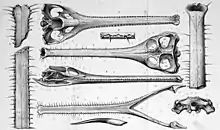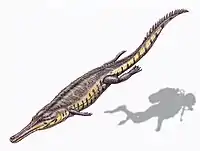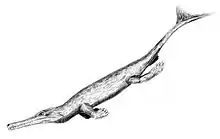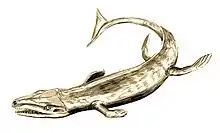Teleosaurus
Teleosaurus is an extinct genus of teleosaurid crocodyliform found in the Middle Jurassic Calcaire de Caen of France.[1] It was approximately 3 metres (10 ft) in length.[2] The holotype is MNHN AC 8746, a quarter of a skull. Other fragmentary specimens are known.[3] A single species, T. cadomensis, exists.[4] It was previously considered a wastebasket taxon, with many other remains assigned to the genus.[5][3]
| Teleosaurus | |
|---|---|
 | |
| Holotype skull of T. cadomensis seen from multiple angles | |
| Scientific classification | |
| Kingdom: | Animalia |
| Phylum: | Chordata |
| Class: | Reptilia |
| Suborder: | †Thalattosuchia |
| Family: | †Teleosauridae |
| Subfamily: | †Teleosaurinae |
| Genus: | †Teleosaurus Geoffroy, 1825 vide Cuvier, 1824 |
| Type species | |
| †Teleosaurus cadomensis (Lamouroux, 1820) | |
| Synonyms | |
| |
History

Teleosaurus was briefly noted on by Jean Vincent Félix Lamouroux in 1820 as Crocodilus cadomensis and then he sent the specimen to Georges Cuvier.[6] It was fully described by Cuvier in 1824,[7] but it was not published until a year later by Étienne Geoffroy Saint-Hilaire.[4]
The second species attributed to Teleosaurus, T. soemmeringii (now a synonym of T. cadomensis), was named in 1829.[8] In 1842, T. asthenodeirus, was named.[9] T. minimus and T ornati were named in 1852 and it is now firmly a synonym of T. cadomensis.[10] Quenstedt also added T. lacunosae several years later in 1858. Eudes-Deslongchamps followed in 1868, naming the two species T. geoffroyi and T. gladius - both are based on remains destroyed in Caen in 1944. T. geoffroyi, described on the basis of now destroyed mandibular fragments, was considered a valid species by Vignaud (1995),[11] but it became a probable synonym of T. cadomensis in 2020.[3] Richard Owen added T. brevior and T. latifrons to Teleosaurus in 1884.[12]
In 2019, the taxonomy of Teleosauroidea was reviewed and T. cadomensis was seen as the only valid species.[5] The rest of the known species were absorbed into T. cadomensis or other genera.[5][3] This study was published in October 2020.[3]
Description
Teleosaurus had highly elongate jaws, similar to those of a modern gharial.[9] It had a long, slender, body, with a sinuous tail that would have helped propel it through the water. Its forelimbs were remarkably short, and would probably have been held close to the body when swimming to improve the animal's streamlining. Unlike modern crocodilians, it lived in the open ocean, and it probably caught fish and squid with its sharp, needle-like teeth.[13]
References
- Weishampel, David B; et al. (2004). "Dinosaur distribution (Middle Jurassic, Europe)." In: Weishampel, David B.; Dodson, Peter; and Osmólska, Halszka (eds.): The Dinosauria, 2nd, Berkeley: University of California Press. Pp. 538–541. ISBN 0-520-24209-2.
- P. H. Phizackerley (1951). A revision of the Teleosauridae in the Oxford University Museum and the British Museum. The Annals and Magazine of Natural History 12(4): 1170–1192.
- Johnson, Michela M.; Young, Mark T.; Brusatte, Stephen L. (2020). "The phylogenetics of Teleosauroidea (Crocodylomorpha, Thalattosuchia) and implications for their ecology and evolution". PeerJ. 8: e9808. doi:10.7717/peerj.9808.
- Geoffroy Saint-Hilaire É (1825) Recherches sur l’organisation des gavials. Mém Mus Natl Hist Nat 12: 97–155.
- "The taxonomy, systematics and ecomorphological diversity of Teleosauroidea (Crocodylomorpha, Thalattosuchia), and the evaluation of the genus 'Steneosaurus'". Archives of the University of Edinburgh. 2019.
- Lamouroux, M (1820) Sur le crocodile fossile trouvé dans les carrières du Bourg d'Allemagne, a un quart de lieue de Caen. Annales générales des Sciences physiques.
- Cuvier G (1824) Article IV Des os de deux espèces inconnues de Gavials; trouvés pêle-mêle près de Honfleur et du Hâvre. Sur les Ossemens Fossiles. Nouvelle édition, Tome Cinquieme, Partie 2 Paris: Dufour & d’Occagne. 143–160.
- F. Holl. 1829. Handbuch der Petrefactenkunde, mit einer Einleitung über die Vorwelt der organischen Wesen auf der Erde von Dr. Ludwig Choulant 1:1-115
- R. Owen (1842). Report on British fossil reptiles, part II. Report of the British Association for the Advancement of Science 11: 60-204.
- Von Quenstedt FA. (1852). Handbuch der Petrefaktenkunde. Tübingen: Laupp.
- Vignaud, P., “The Thalattosuchia, Mesozoic marine crocodiles: phylogenetic systematics, paleoecology, biochronology and palaeogeographical implications." Unpublished PhD thesis, University of Poitiers, 1995, p.410
- R. Owen. 1884. A History of British Fossil Reptiles, Part III. 1-199
- Palmer, D., ed. (1999). The Marshall Illustrated Encyclopedia of Dinosaurs and Prehistoric Animals. London: Marshall Editions. p. 99. ISBN 1-84028-152-9.


